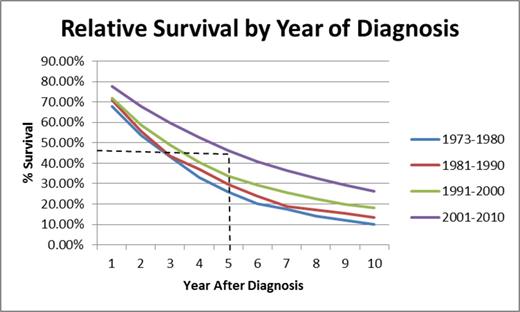Abstract
BACKGROUND: Multiple myeloma survival has significantly improved with the introduction of new therapeutic classes in the early 2000s. The magnitude of improvement in survival with better tolerated therapy is essentially transforming the disease from an acute condition, to a potentially manageable chronic disease . The impact of further advances in multiple myeloma therapy is not yet known but can be projected based on analysis of historical data and positive outcomes that are expected for future clinical trials.
METHODOLOGY: Analysis of data from the Surveillance, Epidemiology and End Results (SEER) were performed using SEERStat software. The first part of this analysis compares the median relative survival, based on cohort analysis, and five year relative survival, based on period analysis, for different time periods that coincided with the introduction of newer, better tolerated, more effective therapies for treating multiple myeloma. The second part of this analysis attempts to estimate future changes in survival, that may potentially result from additional disease modifying therapies planned to become available over the next 5-10 years. This will be accomplished through analysis of evidence-based metrics including extrapolation from early phase clinical trial data and validation with key opinion leaders.
RESULTS: Median, cumulative and 5 year relative survival of multiple myeloma have improved over the last decade primarily as a result of the introduction of newer therapies such as thalidomide, lenalidomide and bortezomib. Based on analysis of SEER data, median relative survival from the 1980s to 2000 showed modest changes, averaging approximately 30 months through the two decades. Thereafter, median survival increased to nearly 50 months by 2007 (FIGURE 1). Five year relative survival improved from about 30% in 1990 to over 46% in 2010 (FIGURE 2).
SUMMARY: This analysis highlights the dramatic improvements in multiple myeloma survival over the last three decades in the U.S., and demonstrates the transformative impact and value of novel therapies for multiple myeloma. The most substantial improvements were observed during the period between 2001 and 2007, when multiple myeloma median survival rates increased by 45%. This improvement has predominantly been driven by the introduction of novel classes of drugs and agents, including immunomodulatory and proteasome inhibitors. Over the next 10 years we expect to see a similar trend, where further advances in the treatment of multiple myeloma will yield additional novel therapies that could result in improvements of comparable or better magnitude.
Kaura:Celgene: Employment, Equity Ownership. Kiely:Celgene: Employment, Equity Ownership. Hussein:Celgene: Employment, Equity Ownership. Durie:Celgene: Advisory Board Celgene, IRC Onyx, DMC Millennium, IRC J&J Other.
Author notes
Asterisk with author names denotes non-ASH members.



This feature is available to Subscribers Only
Sign In or Create an Account Close Modal